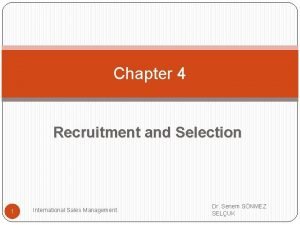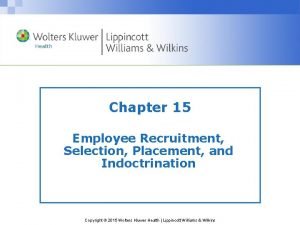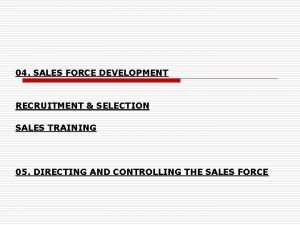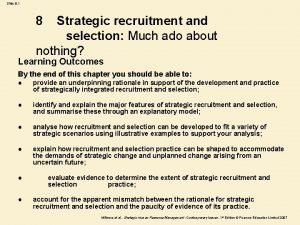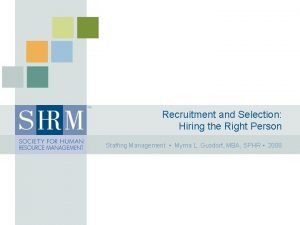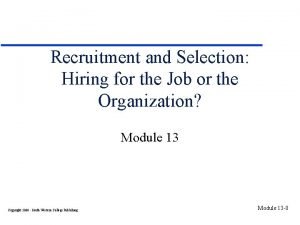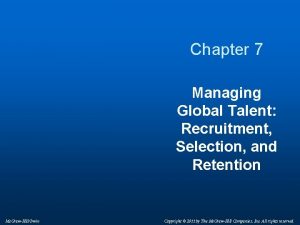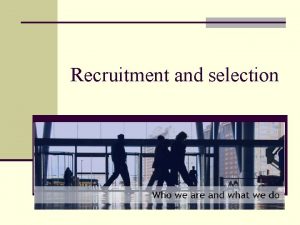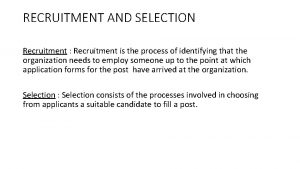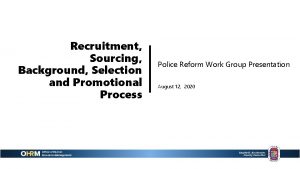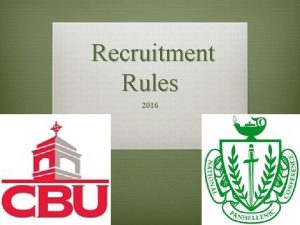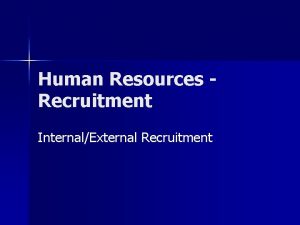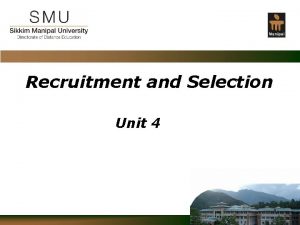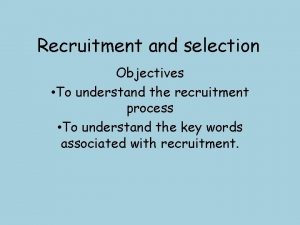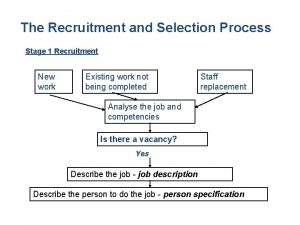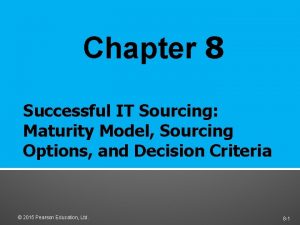CHAPTER 6 Sourcing Recruitment Selection and Orientation Overview

































- Slides: 33

CHAPTER 6 Sourcing: Recruitment, Selection, and Orientation Overview • • • The Labor Market Determining Labor Needs Recruiting Selecting the Right Person Negligent Hiring Orientation Copyright © 2012 by John Wiley & Sons, Inc. All Rights Reserved

CHAPTER 6 Sourcing: Recruitment, Selection, and Orientation The Labor Market • The supply of people looking for jobs & the jobs available in the given area. • You are looking for people with certain characteristics & they are looking for jobs with certain characteristics. • The U. S. unemployment rate fluctuates around 9. 1%. • The NRA estimates that the number of jobs in the industry will grow by 15% over the next decade. Copyright © 2012 by John Wiley & Sons, Inc. All Rights Reserved

CHAPTER 6 Sourcing: Recruitment, Selection, and Orientation Jobs to be Filled Many of the jobs in food & lodging operations: • demand hard physical labor. • are filled with safety hazards. • are uninteresting & monotonous. • are entry level pay, but with the possibility of promotion. Copyright © 2012 by John Wiley & Sons, Inc. All Rights Reserved

CHAPTER 6 Sourcing: Recruitment, Selection, and Orientation Days & Hours of Work • Days & hours are irregular, scheduling patterns vary aencourage split shifts, part time jobs, unusual hours, being on call • You also have varying needs according to days of the week. • These form a fairly predictable pattern, (i. e. weekends, holidays, banquets, schools, & hospitals). • Predictable enough for you to plan your hiring & scheduling. Copyright © 2012 by John Wiley & Sons, Inc. All Rights Reserved

CHAPTER 6 Sourcing: Recruitment, Selection, and Orientation Sources of Workers • • • The U. S. work force changes continually. The majority of new workers are women, minorities, & immigrants. If the job you’re looking to fill is above the lowest level, the first place to look is inside your own operation. Upgrading someone whose attitudes and performance you already know is far less risky than hiring someone new and will probably assure you of a good, loyal worker. Giving your workers the first chance to fill a vacant job increases employee morale. Copyright © 2012 by John Wiley & Sons, Inc. All Rights Reserved

CHAPTER 6 Sourcing: Recruitment, Selection, and Orientation Sources of Workers The top nine recruiting methods are: 1. 2. 3. 4. 5. 6. 7. 8. 9. In-house job referral Company website Social media Newspaper/magazine Job fairs Online resumes Schools Employment agencies Professional/industry association Copyright © 2012 by John Wiley & Sons, Inc. All Rights Reserved

CHAPTER 6 Sourcing: Recruitment, Selection, and Orientation Major Sources of Workers • • 1 st job Students Women “Moonlighters” Unemployed Just want to get away Retired Disabled Copyright © 2012 by John Wiley & Sons, Inc. All Rights Reserved

CHAPTER 6 Sourcing: Recruitment, Selection, and Orientation Your Labor Area • Know the labor market in your own industry: prevailing wages, unemployment rates, its makeup, competing enterprises. • Know the demographics: ethnic groups, income levels, education levels, where the different groups live. • Know about the community: schools, employment agencies, transportation patterns. Copyright © 2012 by John Wiley & Sons, Inc. All Rights Reserved

CHAPTER 6 Sourcing: Recruitment, Selection, and Orientation Defining Job Qualifications Job Specification lists the qualifications needed to perform a given job, including: Knowledge, info. needed to perform job duties. Skills & abilities, competence needed to perform a task. Performance standards, specific skills you are looking for. The qualifications that you list in your job specification must not discriminate in any way Phrase job requirements in concrete terms. Copyright © 2012 by John Wiley & Sons, Inc. All Rights Reserved

CHAPTER 6 Sourcing: Recruitment, Selection, and Orientation Figure 6. 1 Job specifications. Copyright © 2012 by John Wiley & Sons, Inc. All Rights Reserved

CHAPTER 6 Sourcing: Recruitment, Selection, and Orientation Forecasting Staffing Needs • Anticipating your needs for staff gives you more time to look for the right people. • Records of past sales or occupancy, or special events may indicate trends in people needs. • Scheduling & downtime are key factors in forecasting your personnel needs. Copyright © 2012 by John Wiley & Sons, Inc. All Rights Reserved

CHAPTER 6 Sourcing: Recruitment, Selection, and Orientation Schedule • Let your employees know that you value their opinion. • Try to meet the needs of both- your employee & the company. • Examine your schedule for efficiency of your needs & ways of organizing shifts to be more attractive to employees needs. • Consider revamping. Copyright © 2012 by John Wiley & Sons, Inc. All Rights Reserved

CHAPTER 6 Sourcing: Recruitment, Selection, and Orientation Downtime • The length of time a position is vacant until a employee that can fully perform fills it. • Forecast appropriately for downtime. • If necessary fill out a employment requisition form. Copyright © 2012 by John Wiley & Sons, Inc. All Rights Reserved

CHAPTER 6 Sourcing: Recruitment, Selection, and Orientation Training Versus Buying Skills • There is no security in hiring for experience. • You may have to pay more to break years of bad habits. • If you do hire for experience be sure to check references. • Training is expensive but likely to be less costly in the end. • You really do not have time not to train people! Copyright © 2012 by John Wiley & Sons, Inc. All Rights Reserved

CHAPTER 6 Sourcing: Recruitment, Selection, and Orientation Recruiting • A form of marketing. Looking actively for people to fill jobs. • Be appropriate - put your message out in appropriate places. • Be competitive - sell your job as well as others. • Be constant - on the look out all the time. • Pay attention to drop-in applicants. Copyright © 2012 by John Wiley & Sons, Inc. All Rights Reserved

CHAPTER 6 • • Sourcing: Recruitment, Selection, and Orientation On-line Applicants & Selection Tests Many companies have a space for employment opportunities on their Web sites. This free advertising is attracting an increasing number of applicants. Applications can be completed on-line saving both time & money. Applicants may also be asked to complete selection tests on-line: • Cognitive ability tests, aptitude tests, personality tests, honesty/integrity tests, substance abuse tests. Copyright © 2012 by John Wiley & Sons, Inc. All Rights Reserved

CHAPTER 6 Sourcing: Recruitment, Selection, and Orientation Internal Recruiting • Promoting from within. • To let all employees know about a opening use a job posting. • Advantages include: rewarding employees for doing a good job, it motivates employees and gives them something to work toward, and it maintains consistency within the enterprise. Copyright © 2012 by John Wiley & Sons, Inc. All Rights Reserved

CHAPTER 6 Sourcing: Recruitment, Selection, and Orientation External Recruiting • • Seeking applicants from outside the operation. Can be done via company website. 2 types of advertising are classified & displayed. How to apply: Open or Blind. Advertise in a major paper. Some employers use radio or television. Advertise in your own operation. Copyright © 2012 by John Wiley & Sons, Inc. All Rights Reserved

CHAPTER 6 Sourcing: Recruitment, Selection, and Orientation Figure 6. 6 Display ad. Copyright © 2012 by John Wiley & Sons, Inc. All Rights Reserved

CHAPTER 6 Sourcing: Recruitment, Selection, and Orientation Major Sources of Workers • • 1 st job Students Women “Moonlighters” Unemployed Just want to get away Retired Disabled Copyright © 2012 by John Wiley & Sons, Inc. All Rights Reserved

CHAPTER 6 Sourcing: Recruitment, Selection, and Orientation Major Sources of Workers • Practiced primarily by large organizations seeking management or top level culinary skills. • Recruiters go where the job seekers are - colleges, job fairs, etc. • Advantage: you may get better employees & you are creating a good image for the future. • Additional external sources - organizations involved with minorities, women, disabled, immigrants or other special groups. Copyright © 2012 by John Wiley & Sons, Inc. All Rights Reserved

CHAPTER 6 Sourcing: Recruitment, Selection, and Orientation Evaluating Your Recruiting • • • Learn what sources give you the best workers. Learn what the success rates are. Learn what the costs are. Learn the tenure of people from each source. Also evaluate your own recruiting efforts. Copyright © 2012 by John Wiley & Sons, Inc. All Rights Reserved

Sourcing: Recruitment, Selection, and Orientation CHAPTER 6 Selecting the Right People The Application: A fact finding sheet for each applicant. Asks relevant and job-related questions. The Interview: Find a quiet place free of distractions. Listen attentively. Prepare a list of questions based on the job description. You are after two kinds of information: hard data on skills and experience and personal qualities important to the job. Copyright © 2012 by John Wiley & Sons, Inc. All Rights Reserved

CHAPTER 6 Sourcing: Recruitment, Selection, and Orientation Selecting the Right People Evaluate the applicant immediately on your list of specifications for the job, using a rating system that is meaningful to you, such as a point system or a descriptive ranking: 1. 2. 3. 4. exceptional, hire immediately well qualified with reservations not qualified Copyright © 2012 by John Wiley & Sons, Inc. All Rights Reserved

CHAPTER 6 Sourcing: Recruitment, Selection, and Orientation Evaluation • Can-do Factors: includes job knowledge, past experience, & education. • Will-do Factors: includes the applicants willingness, desire, & attitude toward performing the job. • Halo effect- or overgeneralization: Jumping to conclusions based on 1 st impressions. • Truth in Hiring: telling the applicant the entire story about the job, including drawbacks. Copyright © 2012 by John Wiley & Sons, Inc. All Rights Reserved

CHAPTER 6 Sourcing: Recruitment, Selection, and Orientation Testing • • Some companies use tests as an additional method of evaluating applicants. Various tests are used: • • • Skills tests measure specific skills Aptitude test measure ability to learn. Psychological tests measure personality traits. Medical examinations measure physical fitness. To use a test it must be reliable, valid, & relevant. The Employee Polygraph Protection Act of 1988 prohibits the use of polygraphs in screening for job applicants. Copyright © 2012 by John Wiley & Sons, Inc. All Rights Reserved

CHAPTER 6 Sourcing: Recruitment, Selection, and Orientation Reference Check • The final step helps to weed out applicants who have falsified or stretched their credentials. • 1 st verify substance issues - factual info. about the applicant. • Style determines how someone did in previous jobs, how well the got along with others. • If you neglect the reference check you run the risk of hiring a problem worker! Copyright © 2012 by John Wiley & Sons, Inc. All Rights Reserved

CHAPTER 6 Sourcing: Recruitment, Selection, and Orientation Making the Choice 1. Don’t jump to hire someone you have previously known. Look at the big picture! 2. Don’t hire too quickly. 3. Don’t rush to hire the applicant who interviewed the best. 4. Don’t hire on intuition. 5. Don’t hire just because someone is highly recommended. When you make the offer do it in writing, include all conditions. Copyright © 2012 by John Wiley & Sons, Inc. All Rights Reserved

CHAPTER 6 Sourcing: Recruitment, Selection, and Orientation Making the Choice 1. Making the Offer The following points should appear in the offer letter, as appropriate: • Meal arrangements • • Department Position title Supervisor Location Rate of pay Schedule of shift When jobs start, where to report, whom to report to • Clothing & equipment needed • Parking • Arrangements for orientation/training • Brief description of benefits • Probationary period • Appointment time for filling out additional personnel forms (such as the I-9 form) Copyright © 2012 by John Wiley & Sons, Inc. All Rights Reserved

CHAPTER 6 Sourcing: Recruitment, Selection, and Orientation Negligent Hiring • Failure of an employer to take reasonable and appropriate safeguards when hiring employees to make sure that they are not the type to harm guests or other workers. • Fear of negligent hiring & retention litigation is a hiring manager’s worst nightmare & the most compelling reason to conduct in-depth criminal records searches of job applicants. Copyright © 2012 by John Wiley & Sons, Inc. All Rights Reserved

CHAPTER 6 Sourcing: Recruitment, Selection, and Orientation • Introduces each new employee to the job & the workplace. • Tells new staff members what they want to know & what the company wants them to know. • To communicate this information you can give out a employee handbook. • This creates positive employee attitudes toward the company & the job. Copyright © 2012 by John Wiley & Sons, Inc. All Rights Reserved

Sourcing: Recruitment, Selection, and Orientation CHAPTER 6 Creating a Positive Response You want to: • Create an image of the company as a good place to work. • To foster certain feelings in your new people: that they are needed & wanted. • Create the beginnings of a sense of belonging. • Reduce anxieties & promote confidence & security. Copyright © 2012 by John Wiley & Sons, Inc. All Rights Reserved

CHAPTER 6 Sourcing: Recruitment, Selection, and Orientation Communicating Necessary Information • • Employees want to know certain information (i. e. pay rate, overtime, days & hours of work, etc. ). Employers want them to know this, plus other information (i. e. rules & regulation, company policy etc. ). • You can have it all printed in a booklet, commonly called an employee handbook. • Give them the booklet to take home. • An orientation checklist is an excellent tool for telling your employees what they need to know. Copyright © 2012 by John Wiley & Sons, Inc. All Rights Reserved
 Difference between reactive sourcing and strategic sourcing
Difference between reactive sourcing and strategic sourcing What is recruitment means
What is recruitment means Recruitment selection and induction policies and procedures
Recruitment selection and induction policies and procedures Meaning of recruitment and selection
Meaning of recruitment and selection Recruitment and selection course outline
Recruitment and selection course outline Meaning of recruitment and selection
Meaning of recruitment and selection Differentiate between recruitment and selection.
Differentiate between recruitment and selection. Objective of recruitment and selection
Objective of recruitment and selection Job analysis recruitment and selection
Job analysis recruitment and selection Question paper of hrm
Question paper of hrm International sales recruitment
International sales recruitment Phases of indoctrination
Phases of indoctrination Recruitment and selection of sales force
Recruitment and selection of sales force Strategic selection process
Strategic selection process Selection in staffing
Selection in staffing Definition of recruitment and selection
Definition of recruitment and selection New trends in recruitment and selection
New trends in recruitment and selection Recruitment and selection in human resource management
Recruitment and selection in human resource management Recruitment and selection definition
Recruitment and selection definition Recruiting yield pyramid
Recruiting yield pyramid Objectives of resourcing strategy
Objectives of resourcing strategy Difference between hiring and recruitment
Difference between hiring and recruitment Recruitment selection and placement
Recruitment selection and placement Example of polycentric orientation
Example of polycentric orientation Talent acquisition meaning
Talent acquisition meaning Global recruitment selection
Global recruitment selection Two way selection and multiway selection in c
Two way selection and multiway selection in c Multiway selection
Multiway selection Procedure of pure line selection
Procedure of pure line selection Balancing selection vs stabilizing selection
Balancing selection vs stabilizing selection Similarities
Similarities K selected
K selected Natural selection vs artificial selection
Natural selection vs artificial selection Artificial selection vs natural selection
Artificial selection vs natural selection










